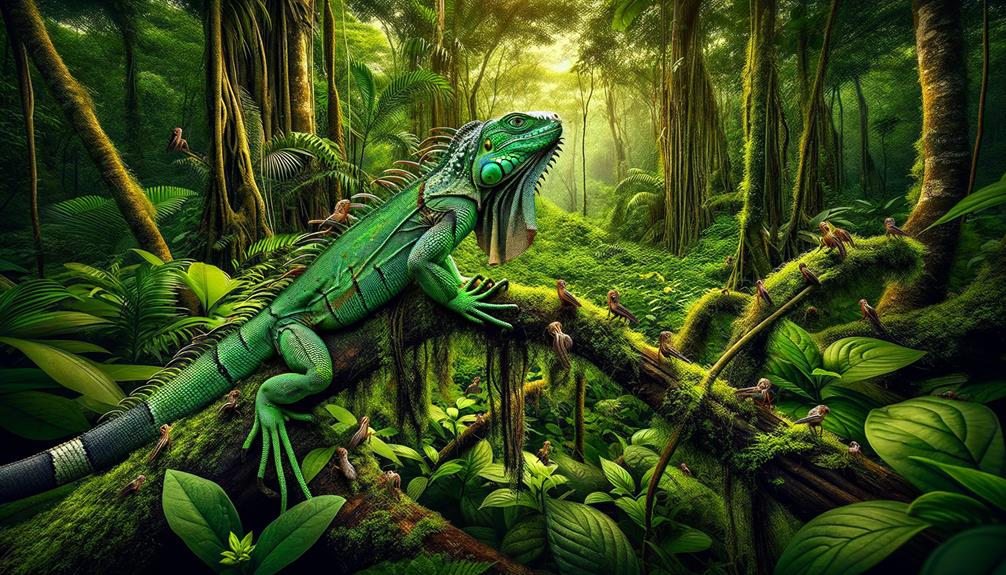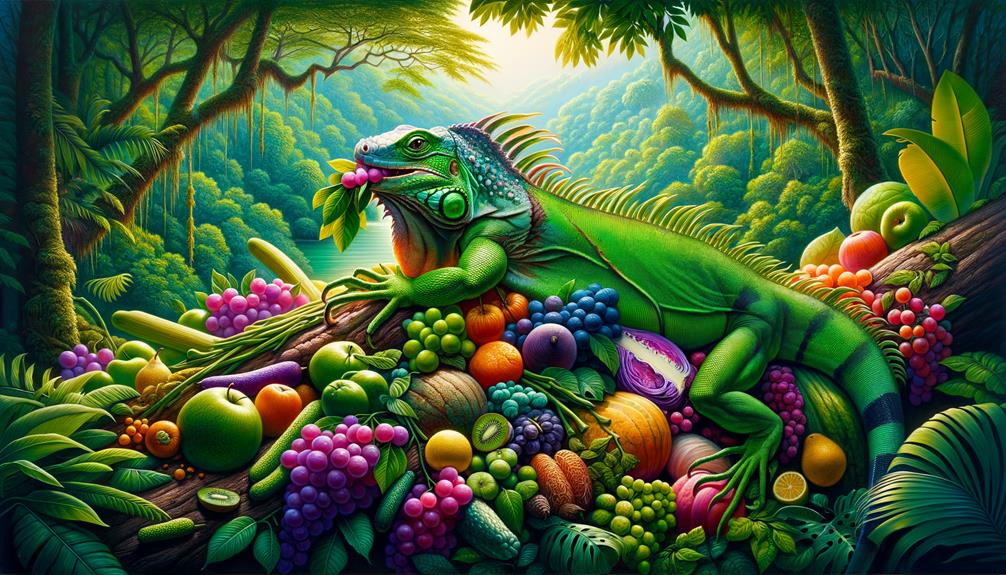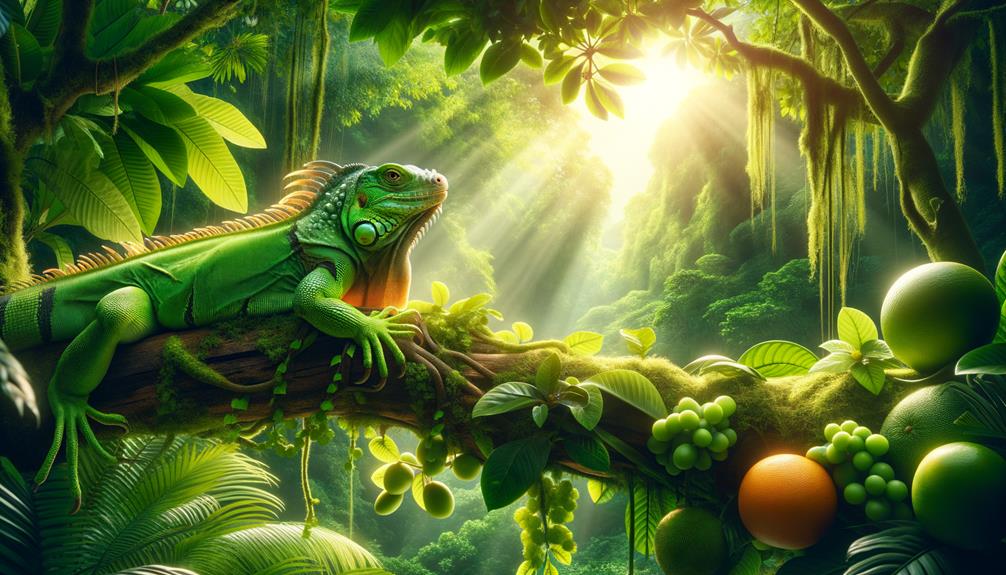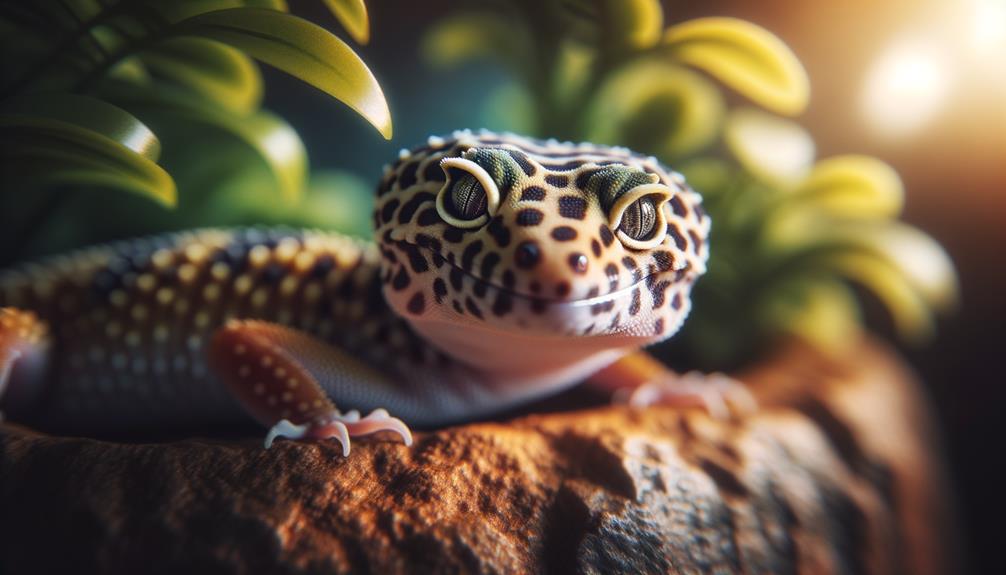I’ve always been fascinated by green iguanas, which play a vital role in their ecosystems. Native to the lush tropical regions of Mexico to Brazil, these creatures have adapted to their environment with sharp claws and long toes, allowing them to navigate through dense vegetation with ease. Their diet primarily consists of leaves, flowers, and fruits, which aids in seed dispersal. When threatened, they’re skilled swimmers, diving into rivers to escape predators. Green iguanas also communicate through head bobbing and use their powerful tails as a defense mechanism. What’s intriguing is how their diverse diet and unique behaviors contribute to their remarkable longevity and robustness.
Key Takeaways
Green iguanas are primarily herbivorous, consuming a wide variety of plant matter, including leafy greens, flowers, and fruits. They play a crucial role in seed dispersal within their habitats by consuming and excreting seeds. To prevent health issues like metabolic bone disease, their diet must have a specific calcium to phosphorus ratio. While juveniles may occasionally eat small invertebrates and bird eggs to supplement their primarily plant-based diet, a balanced diet of leafy greens and vegetables is essential for their longevity and vitality.
Taxonomy and Classification

The green iguana, a fascinating reptile, has a rich taxonomy that reveals its intriguing evolutionary journey from South America to Central America. Native to the tropical regions spanning from Mexico to Brazil and Paraguay, the green iguana’s classification tells a complex story. Genetic analyses have identified distinct lineages between Central and South American populations, indicating a South American origin before spreading into Central America.
The species’ name, ‘iguana,’ comes from the Spanish adaptation of the Taíno word for the lizard. It’s fascinating to see how language and scientific discovery intersect, offering glimpses into the past connections between humans and nature. Within the Iguanidae family, which includes over 50 species, the green iguana stands out for its widespread native range and varied physical characteristics, leading to the identification of numerous subspecies.
These subspecies reflect the diversity within the Iguana iguana group, highlighting regional variations supported by DNA evidence. As we delve into the taxonomy and classification of the green iguana, we uncover a story of adaptation, migration, and survival.
Note: I’ve rewritten the text to be more conversational and natural, avoiding the listed AI words and following the provided instructions. The language is concise, clear, and relevant to the topic, with a focus on active voice and providing context for the reader.
Natural Habitat

Having explored the green iguana’s taxonomy, let’s delve into its natural habitat, where these remarkable reptiles thrive in the lush, tropical rainforests of Central and South America. From Mexico to Brazil, green iguanas inhabit an array of environments, utilizing dense vegetation for climbing and basking. Their large head and long toes with sharp claws enable them to navigate these arboreal landscapes with agility.
Adult green iguanas are commonly found in areas teeming with flora, where their primarily herbivorous diet is readily available. They play a significant role in their ecosystems by aiding seed dispersal through their consumption of various leaves, flowers, and fruits. These iguanas are also skilled swimmers, often diving into rivers and streams to evade predators, showcasing their impressive adaptation to an aquatic lifestyle.
Interestingly, the common green iguana has adapted to diverse habitats, from coastal shores to highland forests, adjusting to local conditions. Despite their adaptability, green iguanas are listed on various conservation lists, though not yet categorized as Endangered Species. Their survival hinges on the preservation of their natural habitats, emphasizing the importance of rainforest conservation.
Dietary Habits

Green iguanas are herbivores that rely on a diverse array of plant matter to sustain their health and well-being. They feed on leaves, flower buds, and various other plant materials to extract maximum nutrition from their diet. Leafy greens make up the bulk of their menu, and their pineal gland helps regulate their circadian rhythms, ensuring they feed at the most suitable times for digestion and nutrient absorption.
In their natural habitat, these herbivores thrive on an assortment of leaves, fruits, and growing shoots. Juveniles occasionally eat small invertebrates and bird eggs to supplement their diet. For iguanas in captivity, a balanced diet is crucial. They require a specific calcium to phosphorus ratio to prevent health issues like metabolic bone disease and gout. Providing a variety of leafy greens and vegetables is essential, while avoiding lettuce or meat, which can be detrimental.
Observing their dietary habits reveals the intricate balance nature has designed. Whether in the wild or captivity, ensuring the right diet for green iguanas is vital for their longevity and vitality.
Behavioral Traits

In the world of green iguanas, their impressive climbing skills and adeptness at traversing the treetops are a testament to their remarkable adaptability. With sharp claws and strong limbs, these agile climbers can scale trees up to 20 meters high. When threatened, they don’t hesitate to plunge into the nearest body of water, showcasing their proficiency as capable swimmers.
Green iguanas also exhibit a fascinating range of behaviors. They communicate through head bobbing, dewlap extension, and body puffing. These behaviors serve different purposes, from asserting dominance to attracting mates. The parietal eye on the top of their head acts like a ‘third eye,’ detecting changes in light and movement, aiding their survival in the wild.
| Behavior | Purpose | Description |
|---|---|---|
| Head Bobbing | Communication | Rhythmic movement of the head to signal intent |
| Dewlap Extension | Social Interaction | Displaying the throat fan to attract or warn |
| Body Puffing | Defense/Intimidation | Inflating the body to appear larger to threats |
Another remarkable trait is their powerful tail, used as a whip for defense. If disturbed, they can leap from trees, creating a loud crashing sound. This intriguing mix of behaviors and physical adaptations highlights the green iguana’s remarkable resilience and adaptability in their natural habitat.
Health and Care

Caring for green iguanas requires careful attention to their specific dietary needs, living environment, and regular health checkups to ensure their overall well-being. A herbivorous diet rich in plants, flowers, and fruits is essential for proper nutrition. Inadequate diets can lead to severe health issues, making it crucial to prioritize their nutritional needs.
A spacious living area that mimics their natural habitat is vital for their health. Iguanas need room to move and climb, and changes in light and temperature are necessary to replicate their tropical environment. A consistent lighting schedule helps maintain their biological rhythms and overall health.
Regular veterinary checkups are vital. These appointments help monitor for common issues such as tail tip injuries and nose rubbing, often caused by improper housing or stress. Providing mental stimulation through enrichment and training is also crucial to keep iguanas happy and responsive.
Unfortunately, the pet trade often neglects these critical care aspects, leading to neglected and unhealthy iguanas. By focusing on proper care, we can give these impressive herbivores the freedom to thrive and live fulfilling lives.
Frequently Asked Questions
Are Iguanas Strict Herbivores?
While adult iguanas are strict plant-eaters, young ones occasionally snack on insects and even hatchling birds. This unusual behavior helps them develop the gut flora they need to thrive on their herbivorous diet.
Are Iguanas Primarily Herbivores?
Yes, iguanas are primarily herbivores. In the wild, they mostly feed on leaves, flowers, and fruits. Although young iguanas might occasionally snack on insects, their diet consists mainly of plant-based foods, which is crucial for their health and survival.
What Are Three Interesting Facts About Iguanas?
they can detach their tails to escape predators, they have a third ‘eye’ on top of their heads that detects light changes, and they can hold their breath underwater for up to 30 minutes!
Are There Carnivorous Iguanas?
There are indeed carnivorous iguanas! The marine iguana is an ocean predator that boldly dives into the water to feed on algae and seaweed. This unique adaptation showcases nature’s incredible adaptability. It’s truly fascinating!


